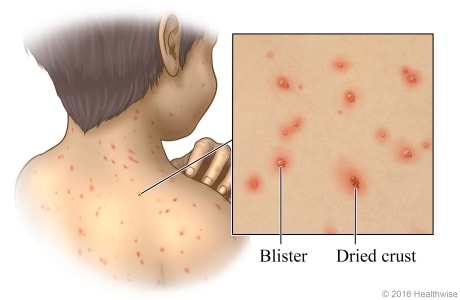Chickenpox (Varicella)
What is chickenpox?
Chickenpox (also called varicella) is a contagious infection that causes an itchy rash and red spots or blisters (pox) all over the body. Chickenpox can be more serious for newborns, teens and adults, and those who are pregnant or who have a weak immune system.
Chickenpox usually isn't serious in healthy children. Children who have chickenpox need to stay home from school or day care so they don't spread it to others.
What causes it, and how is it spread?
Chickenpox is caused by the varicella-zoster virus. It is easily spread (contagious). You can get it from an infected person who sneezes, coughs, or shares food or drinks. You can also get it if you touch the fluid from a chickenpox blister.
What are the symptoms?
The first symptoms of chickenpox are fever, little or no appetite, headache, cough, and sore throat. The itchy rash appears about 1 or 2 days later. New red spots (pox) appear for about 5 to 7 days. It usually takes a week for a blister to crust over.
How is it diagnosed?
A healthy child with chickenpox symptoms may not need to visit a doctor. You may be able to describe the symptoms over the phone. Newborns, teens, adults, and those who are pregnant or who have weak immune systems need to see a doctor for chickenpox right away. It may be more serious for them.
How is chickenpox treated?
Treatment depends on your age, your health, how long it's been since you were exposed to the virus, and your symptoms. Most children need only home treatment for chickenpox. Newborns, people older than age 12, and those who are pregnant or who have a weak immune system need to see a doctor for care.
How can you prevent it?
If you or your child has never had chickenpox or the chickenpox vaccine, you have no immunity against the virus. You can prevent chickenpox by getting the vaccine. If you are pregnant or you have a weak immune system, you may be able to get a shot of antibodies (immunoglobulin) or antiviral medicine to prevent chickenpox.
How it Spreads
Chickenpox can spread easily. You can get it from an infected person who sneezes, coughs, or shares food or drinks. You can also get it if you touch the fluid from a chickenpox blister.
A person who has chickenpox can spread the virus even before they have any symptoms. Chickenpox is most easily spread from 1 to 2 days before the rash appears until all the blisters have crusted over.
Chickenpox usually doesn't spread to people who have had the infection or the chickenpox vaccine.
Prevention
You can prevent chickenpox with the chickenpox vaccine. Children get this vaccine as part of their routine vaccinations.
If you've never had chickenpox or the vaccine, you have no immunity against the virus. If you or your child isn't immune, you can prevent chickenpox by getting the vaccine.
The vaccine is available for:
- All healthy children 12 months of age and older who haven't had chickenpox.
- Healthy people who aren't sure if they've had the vaccine or chickenpox as a child.
- Those who are planning to get pregnant but aren't pregnant yet. Getting the vaccine when not pregnant prevents complications of chickenpox during pregnancy. Talk to your doctor about the right timing for the vaccine. Getting chickenpox during pregnancy can cause birth defects or serious newborn infection.
You can help prevent getting chickenpox by avoiding close contact with people who are infected with the virus. This is even more important if you have a weak immune system.
Preventing chickenpox after being exposed to the virus
If you've been in contact with a person who has chickenpox and aren't sure if you're immune, getting the vaccine may prevent the infection. Or it may make it milder.
If you can't have the chickenpox vaccine (for example, during pregnancy), a shot of antibodies (immunoglobulin) or an antiviral medicine may help prevent the chickenpox.
Symptoms
The first symptoms of chickenpox usually start about 2 weeks after contact with a person infected with the virus.
These first symptoms include:
- A fever.
- Feeling sick, tired, and sluggish.
- Having little or no appetite.
- Headache, cough, and sore throat.
The first symptoms are usually mild in children, but they can be severe in newborns, teens and adults, and those who are pregnant or who have a weak immune system. These symptoms may last throughout the illness.
The itchy chickenpox rash usually appears about 1 or 2 days after the first symptoms start.
After a red spot (pox) appears, it goes through stages. It will blister, burst, dry, and crust over. New red spots will appear every day for about 5 to 7 days.
It usually takes about a week for a blister to crust over. When all the blisters have crusted over, the person with chickenpox can go back to day care, school, or work.
What Happens

Chickenpox (also called varicella) is a contagious infection that causes an itchy rash and red spots or blisters (pox) all over the body. It takes about 1 or 2 days for a chickenpox red spot to go through all of its stages. This includes becoming a blister, bursting, drying, and crusting over. New red spots can appear every day for up to 5 to 7 days.
Problems caused by chickenpox
Skin infection is the most common complication for children under age 5. An infection can form after the rash is scratched. Scratching allows bacteria from the skin or under the fingernails to get into a chickenpox blister. The infection can become serious if it isn't treated. An infected blister also may leave a scar.
After you've had chickenpox, you aren't likely to get it again. But the virus stays in your body long after you get over the infection. If the virus becomes active again, it can cause a painful viral infection called shingles, usually when you are an older adult. There is a vaccine to protect against shingles.
Chickenpox during pregnancy can cause birth defects or serious newborn infection.
Other complications may include pneumonia or encephalitis (inflammation in the brain). These complications are rare but can be very serious.
When to Call a Doctor
Contact your doctor now if you or your child has chickenpox and has:
- A severe headache or constant vomiting, sensitivity to bright light, or unusual sleepiness or confusion. These may be signs of inflammation of the brain (encephalitis).
- Problems breathing or persistent coughing. These may be signs of varicella pneumonia.
- Red, warm, and sore skin, or if the chickenpox rash changes to bigger open sores. These may be signs of serious skin infection.
Call for an appointment with your doctor if:
- You think your newborn has been exposed to the chickenpox virus.
- You are older than age 12, you aren't sure if you have ever had chickenpox or the vaccine, and you have been exposed to chickenpox.
- You or your child has a weak immune system and has been exposed to chickenpox.
- You are pregnant and have been exposed to chickenpox.
- You or your child has chickenpox and any of the following:
- Severe itching that cannot be relieved by home treatment
- Chickenpox rash on the eyeball
- A rash that lasts longer than 2 weeks
If one of these things is true, it's important to see a doctor as soon as you think you or your child has been exposed to the chicken pox virus. The doctor may want to give a medicine or vaccine to help prevent serious problems or protect from getting the virus.
Watchful waiting
A healthy child with chickenpox symptoms may not need to visit a doctor. You may be able to describe your child's symptoms to the doctor over the phone. Then your child won't have to leave the house and risk spreading the virus to others. But it's important to check with your doctor to find out if your child needs to be seen.
If you go to a doctor's office, ask if you need to take any precautions when you arrive to avoid spreading the infection. For example, office staff may take you directly to an exam room when you arrive, rather than have you wait in the lobby.
Exams and Tests
Chickenpox often can be diagnosed based on how the chickenpox rash looks.
A healthy child with chickenpox symptoms may not need to visit a doctor. You may be able to describe the symptoms to the doctor over the phone.
If your child needs to see a doctor, the doctor will ask you questions and do an exam. During the exam, the doctor should be able to tell if you or your child has chickenpox.
Chickenpox usually isn't serious in children. It can be more serious in newborns, teens and adults, and those who are pregnant or who have a weak immune system. These people need to see a doctor for chickenpox right away. This is very important during pregnancy to prevent birth defects and infection in the baby (fetus).
Treatment Overview
Treatment for chickenpox depends on your age, your health, how long it's been since you were exposed to the virus, and your symptoms.
Most healthy children need only home treatment for chickenpox. Home treatment includes rest and medicines to reduce fever and itching.
Be safe with medicines. Read and follow all instructions on the label. Do not give aspirin to children and teens. It has been linked to Reye syndrome, a rare but serious illness.
Soaking in oatmeal baths also helps with itching.
Chickenpox can be more serious in newborns, teens and adults, and those who are pregnant or who have a weak immune system. Your doctor may want to give you an antiviral medicine or vaccine that helps protect you from the virus.
Self-Care
Most healthy children with chickenpox need only home treatment.
If a person has chickenpox, it's best for them to stay quiet and rest. Over-the-counter medicines can help relieve symptoms like itching and fever.
The chickenpox rash itches. Scratching the blisters may cause a skin infection, or scars may form after the blisters heal. Try oatmeal baths and cool compresses. Check with a doctor before giving over-the-counter antihistamines.
Try giving over-the-counter acetaminophen (Tylenol) for fever and pain. Read and follow all instructions on the label. Do not give aspirin to children and teens. It has been linked to Reye syndrome, a rare but serious illness.
Chickenpox can be more serious in newborns, teens and adults, and those who are pregnant or who have a weak immune system. These people need to see a doctor for chickenpox right away.
Reduce the itch
Home treatment can help reduce the itchiness of the chickenpox rash. Try the following tips to make you or your child more comfortable.
- Take lukewarm or cool baths to help reduce itching. Take baths for 20 to 30 minutes as often as needed to stay clean and soothe your itchy skin. Always stay with young children when they are in a bathtub.
- Do not use soap, or use only a mild soap. Soaps that are made for sensitive skin or those for babies are usually mild.
- Add a handful of oatmeal (ground to a powder) to your bath. Or you can try an oatmeal bath product.
- Pat the skin dry after bathing. Don't rub the skin.
- Apply cool compresses to itchy areas.
- Wet a soft cloth with cool water alone or cool water mixed with baking soda. Put the cool compress directly on the skin to cool your skin and relieve itching.
- You can also make an oatmeal paste and apply it to itchy areas. Take some oatmeal (ground to a powder) and mix it with a little bit of warm water to make a paste. Spread the paste on a paper towel. Put the paste side of the towel against the itchy area of skin. Hold it there for 10 to 15 minutes. Then gently rinse the area and pat the skin dry.
- Apply soothing lotions that can help dry chickenpox blisters. You could try lotions with:
- Phenol, menthol, and camphor, such as calamine lotion.
- Oatmeal.
- To help prevent skin irritation and scratching:
- Wear loose-fitting cotton clothing.
- Change clothes daily.
- Use a mild laundry detergent if clothes or bedsheets seem to be irritating the skin.
- Avoid using antihistamine lotions. You may apply too much medicine, which can be harmful. Ingredients to avoid include:
- Diphenhydramine.
- Lidocaine.
- Pramoxine.
- Ask the doctor about taking an over-the-counter antihistamine to help calm the itching. If you use it, carefully follow the directions on the label. They may help prevent you or your child from scratching the rash and blisters, especially during sleep.
- Keep fingernails short, and try wearing gloves to prevent scratching.
- Avoid getting hot and sweating. These trigger itching.
- Stay out of sunlight. A child can play outside in the shade.
Credits
Current as of: September 30, 2025
Author: Ignite Healthwise, LLC Staff
Clinical Review Board
All Ignite Healthwise, LLC education is reviewed by a team that includes physicians, nurses, advanced practitioners, registered dieticians, and other healthcare professionals.
Current as of: September 30, 2025
Author: Ignite Healthwise, LLC Staff
Clinical Review Board
All Ignite Healthwise, LLC education is reviewed by a team that includes physicians, nurses, advanced practitioners, registered dieticians, and other healthcare professionals.


